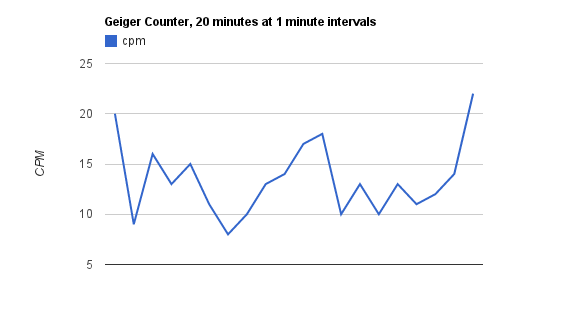
Nick Parlante 7/2012
< Nick's Home
< MrGeiger Software
I've been playing with the Mighty Ohm Geiger Counter -- a neat, cheap, open source little geiger counter with serial output. See also MrGeiger -- free software I've written to process the data coming out of this geiger counter, part of trying to make a CS assignment out of the geiger counter, and an how to put together the USB connection.
A geiger counter measures the radiation level in an area. Many physical features -- like length, or weight, or temperature -- work with your own senses. But radiation has this eery quality that it's going on all around us all the time, but it's not something we can sense (radio waves are similar I suppose).
A geiger counter counts each time some ionizing radiation flies through the air and hits the geiger tube, typically from the random disintegration of a nearby unstable atom. When an unstable atom is going to disintegrate is very random, so the timing of the "hits" on the geiger tube is also very random.
Here's a picture of the MightyOhm geiger counter, and the geiger tube is the pencil-shaped tube at the bottom of the board. The tube is an SBM-20, which is a cheap and commonly available tube. The wires on the right are part of the FTDI usb/serial converter plugged in to the geiger counter (see MrGeiger).

Here's a graph which shows counts per minute, CPM, measured by the above geiger counter sitting in my Stanford office. You can see there there's a lot of randomness in the data.

The standard unit of radiation dosing in an area is the micro-Sievert/hour (uSv/hr). For this tube, multiply its CPM by 0.0057 to get the equivalent uSv/hr radiation level. So the background radiation level in my office is varying roughly between 0.05-0.10 uSv/hr, which is a normal, safe level of background radiation (see Radiation Units below).
Just for fun I hooked the geiger tube up to my cheap USB Oscilloscope (Syscomp Design currently only $189). I'm no physicist, but basically here's how it works: There is a large (400+ V) potential between the two ends of the geiger tube. Normally, very little current flows (the device can run on 2 AAA batteries, so it's not like a lot of current could be supported anyway). However, when a bit of ionizing radiation happens to fly through the tube, it changes (ionizes?) the gas in the tube so it can conduct, and the electric field collapses very abruptly. Count the number of times that happens per minute (CPM) and that's measure of the ambient radiation around the tube. Each type of tube has a conversion from its CPM to a real unit like Sieverts. As mentioned above, for the SBM-20 tube multiplying its CPM by 0.0057 yields uSv/hour.
I must say, the theory of operation displays very nicely on the oscilloscope. Here we see the geiger tube supporting a voltage most of the time, but at the moment the radiation hits it, the voltage collapses and goes dramatically in reverse.

The oscilloscope is set to 200 microseconds per horizontal division, and 200 millivolts per vertical division. However, I connected the oscilloscope though a 5 gigaohm resistor, because the geiger tube power supply is so low-power, it is thrown off by the small current load of a direct oscilloscope connection. The voltage indicated must be multiplied by 5000, so what looks like about 80 millivolts means the tube is actually at about 400 volts. You can see the near-vertical event avalanche of the tube going from about 400 volts to about -4000 volts in a few microseconds. It looks like it takes about 200 microseconds for the tube to recover. I wonder if the tube would recover more quickly with a more substantial power supply. Also the oscilloscope connection is probably distorting the operation of the tube somewhat.
Here's another screenshot that shows two events on the tube. I had to zoom out the horizontal division to 1 millisecond. I placed some slightly radioactive "vaseline glass" beads right on the tube, but it still took many, many events before I got two events within a few milliseconds of each other. Zoomed out this way, you can also see the tube power supply hunting around a little.
Radiation units are confusing! If you remember just one thing, remember that the badness in an area can be expressed as micro-Sieverts/hour (uSv/hr) -- how much badness per hour people in that area are getting. It's cumulative, so if a person is in a 2 uSv/hr area for 6 hours, that's a 12 uSv dose they've accumulated. My house seems to have a natural radiation level of about 0.12 uSv/hour, which is typical and totally harmless. In fact there is some evidence that a low level of radiation is good for health -- makes sense, given that we've evolved on this planet with its level of background radiation.
Generally a person gets around 4 milli-Sieverts per year from natural sources (i.e. 4,000 uSv). The EPA limit to a member of the public for exposure per year over background is 1 milli-Sievert per year. A 100 milli-Sievert dose (i.e. 100 x the EPA limit) is associated with a small but measurable increase in cancer. A chest CT scan is about 7 milli-Sieverts of exposure. In the US, a radiation worker is permitted to get 50 milli-Sieverts per year of exposure. So exposure up to 1 milli-Sievert is quite safe, and up to 10 or 20 is nothing to worry about (lots of people get CT scans for example). See the great Free Radiation Unit Chart from XKCD
See also MrGeiger software and usb connection

Radiation Units